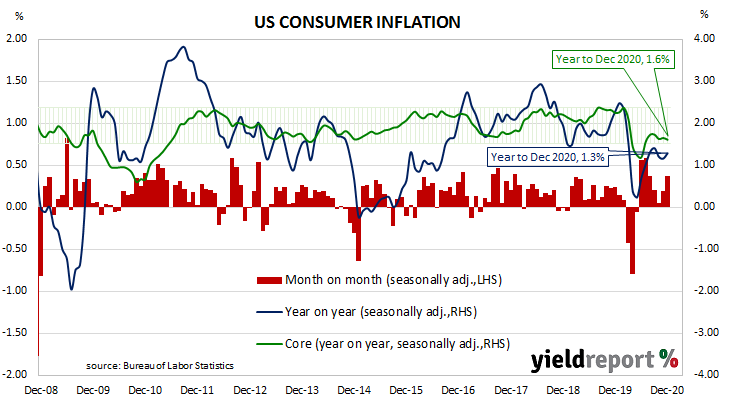Summary: November US CPI up by 0.4%, in line with expectations; “core” rate up 0.1%, “remains subdued”; “some time” for underlying inflation to return to Fed’s 2% target; increase driven by higher fuel prices; used vehicles prices down.
The annual rate of US inflation as measured by changes in the consumer price index (CPI) halved from nearly 3% in the period from July 2018 to February 2019. It then fluctuated in a range from 1.5% to 2.0% through 2019 before rising above 2.0% in the final months of that year. Substantially lower rates were reported from March to May but subsequent reports indicated consumer inflation has largely returned to pre-pandemic levels.
The latest CPI figures released by the Bureau of Labor Statistics indicated seasonally-adjusted consumer prices rose by 0.4% on average in December. The result was in line with expectations but above November’s 0.2% increase. On a 12-month basis, the inflation rate ticked up from 1.2% to 1.3%.

“Headline” inflation is known to be volatile and so references are often made to “core” inflation for analytical purposes. Core inflation, a measure of inflation which strips out the volatile food and energy components of the index, increased by just 0.1% on a seasonally-adjusted basis for the month. This increase was also in line with expectations but lower than November’s comparable figure of 0.2%. The seasonally adjusted annual rate slipped back to 1.6% after ticking up to 1.7% in November.
“Overall core inflation remains subdued, though base effects will clearly see the year-on-year rate lift up due to the large price falls early in the pandemic,” said NAB economist Tapas Strickland.
ANZ economist John Bromhead noted prices of services were the main sources of “softness”. He said, “This is consistent with subdued underlying inflation pressures and imply that it will take time for it to return to the Fed’s 2.0% target.”
US Treasury bond yields fell on the day. By the close of business, the US 2-year yield had slipped 1bp to 0.14%, the 10-year yield had lost 4bps to 1.09% while the 30-year yield finished 5bps lower at 1.82%.
In terms of US Fed policy, expectations of any change in the federal funds range over the next 12 months remained fairly soft. January 2022 futures contracts implied an effective federal funds rate of 0.08%, just below the spot rate of 0.09%.

